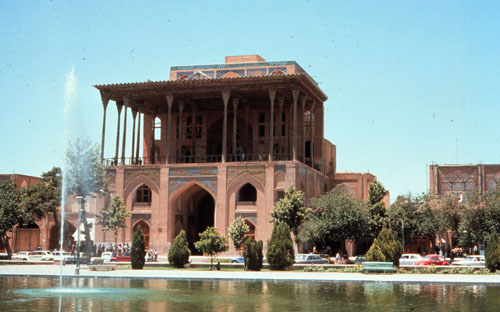
Ali Qapu Palace.
Under Shah Abbas I, Iran prospered. The old Sufi bands, which had been formed into artificial tribal units for military purposes during the dynasty's formative period, were replaced by a standing army trained and equipped on European lines with the advice of Robert Sherley. Sherley was an English adventurer versed in artillery tactics who, accompanied by a party of cannon founders, reached Kazvin with his brother Anthony in 1598.
The bureaucracy was carefully reorganized, but the seeds of the sovereignty's weakness lay in the royal house itself, which lacked an established system of inheritance by primogeniture. A reigning shah's nearest and most acute objects of suspicion were his own sons. Among them, brother plotted against brother over who should succeed on their father's death. Intriguers, ambitious for influence in a subsequent reign, supported one prince against another. Shah Abbas did not adopt the Ottoman sultans' practice of eliminating royal males by murder (as a child he had been within a hair's breadth of being a victim of such a policy). Instead, he instituted the practice of immuring infant princes in palace gardens away from the promptings of intrigue and the world at large. As a result, his successors tended to be indecisive men, easily dominated by powerful religious dignitaries to whom the Safavids had accorded considerable influence in an attempt to make Shi'ism the State religion.
Shah Abbas was a patron of science and scientific achievements as well as of arts. Some of the greatest Iranian philosophers were living under his rule, Molla Sadra, Mir Damad, Moghaddas Ardebili, Sheikh Baha-e-Din Ameli, or Sheikh Bahai who was a great philosopher and scientist. He created a system of heating in a public bath that would provide enough warm water for people to bathe with the power of a single candle!
|
 previous dynasty
previous dynasty




 previous dynasty
previous dynasty
